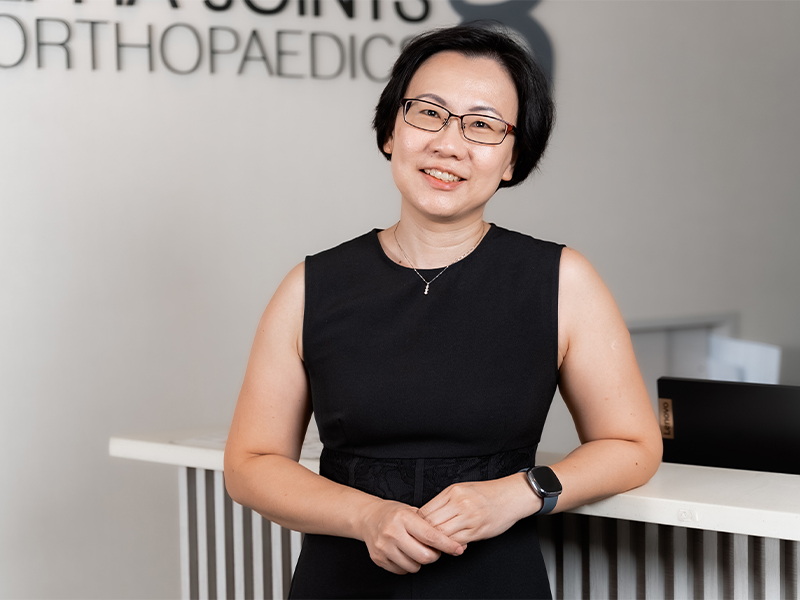Lower back pain in pregnancy is pretty common. In this article, we’ll be taking a closer look at this condition, along with other issues like pelvic girdle pain. There’s no reason to suffer with pregnancy back pain when you should be focusing on more important things – like your growing bump!
French-trained Singaporean orthopaedic surgeon DR FONG POH LING specialises in degenerative spine surgery. She’s passionate about female spine health, especially during pregnancy and postpartum. We asked Dr Fong to explain the causes, symptoms and treatment options available for lower back pain in pregnancy and beyond.

What changes occur during pregnancy that can lead to back pain?
Pregnancy signifies a new phase in life, and a new mother experiences major changes to her body as the baby grows. Hormonal changes result in the ligaments being more lax, so the pelvis is able to widen and accommodate the growing foetus. As the mother carries a heavier load in her belly, there’s increased stress to the lumbar spine as the centre of gravity shifts forward. With loss of pelvic stability and biomechanical changes, up to 45 percent of new mothers face back pain during pregnancy, with 25 percent of those continuing to do so postpartum.

Tell us about the different types of spinal issues commonly faced by pregnant women.
Lower back pain in a new mother can be further subclassified into lumbar pain and pelvic girdle pain (PGP).
Lumbar pain is mainly located at the lumbar spine above the sacrum and is usually associated with back spasms. It’s more activity related, especially during the postpartum period.
PGP, on the other hand, is at the region of the gluteal folds and can sometimes radiate to the posterior thighs or anteriorly around the symphysis pubis. Some women even experience pain around their calves. PGP is more debilitating and associated with prolonged sustained postures and turning. Complete PGP, involving both sacroiliac joints and symphysis pubis, has a worse prognosis.

Why is it so important to accurately identify and treat lumbar pain and pelvic girdle pain?
PGP can cause severe disability in mums, with some even requiring aids and wheelchairs. They’re unable to return to work and daily routines, which leads to poor physical and mental health and a low quality of life. Differentiation between lumbar pain and PGP is also important for prognosis and management. A small number of patients progress to chronic long-term PGP. Risk factors include pre-pregnancy back pain, prolonged labour, a high number of positive pain provocation tests, a low mobility index, the onset of severe pain at early gestation, inability to lose weight following delivery and Complete PGP.
How do you assess and diagnose lower back pain and pelvic girdle pain?
The initial review and diagnosis of lumbar pain and PGP is mainly clinical, with a physical examination and positive provocation testing. At the same time, it’s also important to exclude serious potential spinal conditions like prolapsed intervertebral disc, spinal stenosis or even Cauda Equina Syndrome. This is especially important if the woman is experiencing leg symptoms. For these patients, an MRI (non-contrast) is ideal to evaluate the disc and degree of nerve impingement as it’s safe for the foetus even during the first trimester.
What treatments are available?
Management can take the form of education on posture, ergonomics, anatomy, relaxation techniques or pain management techniques. Identification and understanding of trigger events and activities is also crucial. Physical aids like pelvic belts/binders can offer much needed stability.
Physio treatments from Urban Rehab
Exercise is an important part of treatment, and this is done in conjunction with a physiotherapist. According to the team at leading Singapore specialist rehabilitation group Urban Rehab, every pregnancy is unique, so a personalised plan is needed to suit the woman. Here are some commonly recommended treatments:
#1 Learn strategies for positioning during pregnancy, labour and while caring for baby to maintain joint alignment and reduce pressure on the pelvis and spine.
#2 Perform strengthening exercises for postural and pelvic floor muscles. This is vital in reducing the impact of a growing baby bump. With stretching to the abdominal wall and increasing downward pressure on the pelvic floor, stronger muscles will support your pregnancy, labour and postpartum recovery.
#3 Use bracing or compression wear to support the joints. This is particularly helpful for wrist conditions such as Carpal Tunnel or De Quervain’s, which is so common with new mums it’s often called “Mummy Wrist”!
Lumbar pain and PGP do not have to define your pregnancy, according to Dr Fong. With medical intervention early in pregnancy and a comprehensive treatment plan, you can embrace your motherhood journey with great joy and less pain.
Dr Fong Poh Ling Alpha Joints & Orthopaedics
• #17-12 Paragon Medical Centre, 290 Orchard Road | 6694 6781
• #02-20 Gleneagles Medical Centre, 6 Napier Road | 6479 2488
enquiries@ajo.com.sg | alphajoints.com
Urban Rehab
8816 1244 | info@urban-rehab.org
urbanrehabphysio.com
This article first appeared in the October 2023 edition of Expat Living. You can purchase the latest issue or subscribe so you never miss a copy!
To make the most of living in Singapore, read our latest City Guide here for free!





